Balinese dances on film with music of shimmering yet jarring beauty play together on a South Seas beach in “Legong: Dance of the Virgins.” It’s a rarely screened 1935 silent movie shot entirely in Bali with a Balinese cast, mixed with a new score by Club Foot Orchestra and Gamelan Sekar Jaya. One of the last silent films made by Hollywood, it depicts Bali as Westerners idealized it at the time, stereotypes included. Yet, with authentic Balinese ritual dancing and scenes from everyday society, it transcends the “exploitation film” genre. We include an excerpt of an essay by Peter Bloom and Katherine Hagedorn on the re-release of the film in 2004.
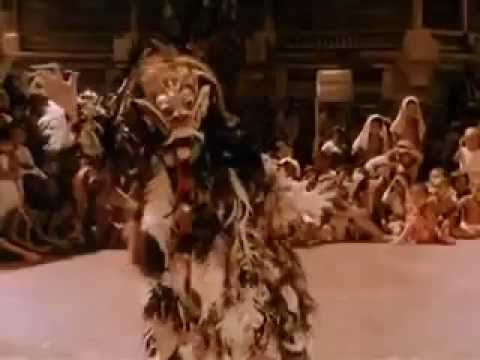
Watch this video on YouTube
Clip from Legong: Dance of the Virgins, produced and directed by Gaston Glass and Marquis Henry de la Falaise for Falaise’s wife Constance Bennett’s Bennett Pictures Corporation, and was filmed entirely on location in Bali from May to August 1933, using an all-Balinese cast.
“Out in the Dutch East Indies, just south of the equator, lies Bali – isle of perpetual summer. In this peopled paradise, untouched by civilization, lives a contented race who joyously worship their gods – to them life is a continuous feast – to them death holds no fear. Here we relate a romance of Balinese life, based on facts and authentic customs – enacted with an all-native case, and produced in its entirety upon the Isle of Bali.” With this exotic invocation opens the film Legong: Dance of the Virgins: A Story of the South Seas.
Essay for the Legong: Dance of the Virgins DVD
An Excerpt By Peter J. Bloom and Katherine J. Hagedorn, For the Full Article, See: Gamelan Sekar Jaya
Historical Context: Bali as Escapist Paradise
In the 1920s and 1930s, Bali was becoming a popular destination for Western artists and intellectuals, who believed that they had found an enchanted land, full of beauty and resonance, far away from the military fantasies of Western Europe. By the mid-1930s, Bali, a Hindu jewel in the Muslim crown of the Indonesian archipelago, was well established as a resort for the jet-set, and about 30,000 tourists visited the island each year. As Tessel Pollmann, a revisionist historian of Balinese history, explains, Bali had well-paved roads, rolling rice fields, and was virtually unspoiled by the ravages of colonial agriculture (1990). The allure of beautiful young girls and willing boys was an added attraction, making Bali the “Eastern Paradise” of the 1930s.
Legong: Dance of the Virgins bears the stamp of the resident European-American intellectual/artist community in Bali during this period. The centerpiece of this vision of Bali was the artist colony in Ubud, whose most famous member, Walter Spies, served as the unofficial guide to the best-known visiting European and American artists, musicians, filmmakers, and anthropologists during the late 1920s and 1930s.
Spies was a Moscow-born German expatriate artist who served as the indispensable cultural broker of interwar Bali, facilitating long-term visits by anthropologists Margaret Mead and Gregory Bateson, composer Colin McPhee and his anthropologist wife Jane Belo, and the dance ethnographer Beryl de Zoete, among others. Spies was perhaps best known for his unique style of painting, which combined “surrealist” techniques with Balinese scenes and myths.
STORY: Hindu Epic ‘Mahabharata’ in Balinese Shadow Theatre and Dance
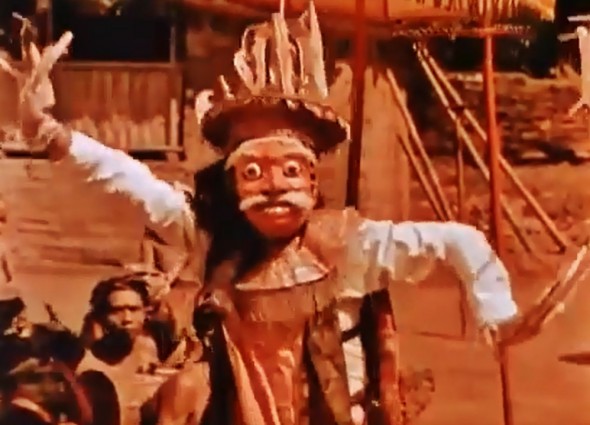

Initially influenced by the work of Otto Dix and Oskar Kokoschka, in a 1919 letter to his father Spies wrote that he wished to “free himself of the indoctrination and prejudices about taste and beauty” in order to find his own style. Spies settled in Bali in 1927, where he lived and painted until his untimely death in 1942. Although no records have been found indicating whether Spies facilitated the making of Legong, it is very likely that La Falaise and his crew were indebted to Spies and other Western expatriates for access to Ubud villages and their ceremonies.
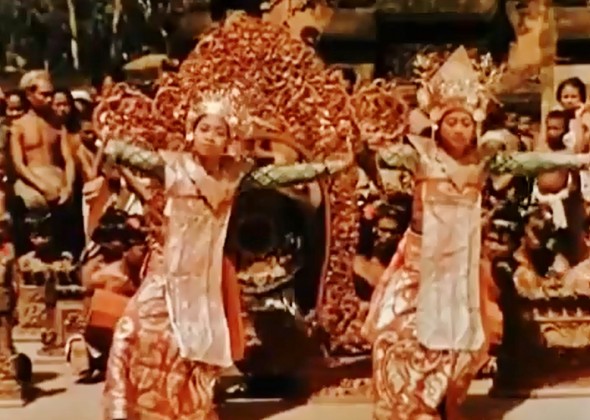

McPhee and Spies were both active in documenting and preserving Balinese performance traditions. McPhee was a well-known Canadian composer and musician whose deep interest in Balinese music inspired him to exhaustively document a wide variety of gamelan genres. Much of this documentation became the subject of his detailed and comprehensive treatise, Music in Bali (1956), a text which remains invaluable to composers and scholars of Balinese music today.
McPhee was particularly interested in transcribing gender wayang, the music produced by pairs of bronze metallophones with bamboo resonators to accompany wayang kulit, the shadow puppet plays depicting stories from the sacred texts of the Ramayana and the Mahabharata. His main informant was the famous Balinese composer I Wayan Lotring, with whom he helped revive old gender wayang traditions by establishing and supporting functioning ensembles to perform that repertoire.
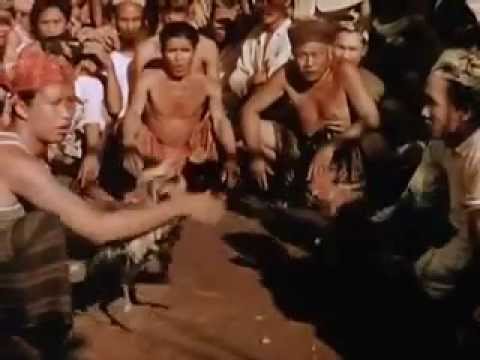
Watch this video on YouTube
Spies – artist, impresario, and musician – was instrumental in reviving kecak, the vocalized “monkey trance dance” performed by groups of eighty men in concentric circles representing the monkey army sent by Prince Rama to rescue his wife Sita. Spies organized and then choreographed the kecak performance that appeared in Victor Baron von Plessen’s 1931 film entitled Insel der Demonen (Island of Demons).
In the context of interwar Bali, the performing arts were rhapsodized by European and American visitors as a “natural” way of being in a “timeless” pre-industrial age. According to Pollmann (1990), the performing arts were part of a “Balinization” policy, which, in the words of Balinese history professor Dr. Ide Gde Ng. Bagus, meant that “the Dutch wanted us to be a living museum” (1990: 15). Balinization served the interests of the tourist economy, and has remained an important focus of the political and economic development of the island to this day. But while Western tourists and artists flocked to Bali during the 1920s and 1930s to enjoy “the good life,” the Balinese peasantry on the island lived in near abject poverty, largely due to the virtual collapse of the export economy, and the exploitative Landrent taxation system, established by the colonial Dutch administration.
American travelogue films about Bali from the 1930s implied the fantasy of female promiscuity, untainted by disease and urban squalor, complemented by a rich cultural performance tradition in an abundant landscape. The disrobed native woman was most often noted in trade reviews of the film travelogues, such as Isle of Paradise (directed and filmed by Charles Trego, 1932) and Goona-Goona [Love Powder] (produced by André Roosevelt and Armand Denis, 1932), both of which were precursors to Legong: Dance of the Virgins. In fact, another version of the detailed cremation ceremony tacked on the end of Goona-Goona was more successfully integrated into the closing segment of Legong: Dance of the Virgins, memorializing Poutou’s suicide.
In each of these films, Bali was presented as a site of timeless beauty and romance. A documentary film that Robert Flaherty had planned to make with F. W. Murnau in Bali during the late 1920s— Bali: The Ultima Thule of Our Desires— was abandoned in favor of Tabu: A Story of the South Seas (dir. Flaherty and Murnau, 1929) (Barnouw 1972). The Latin expression ultima thule refers to the highest degree attainable, and best describes American and European perceptions of Bali as paradise.
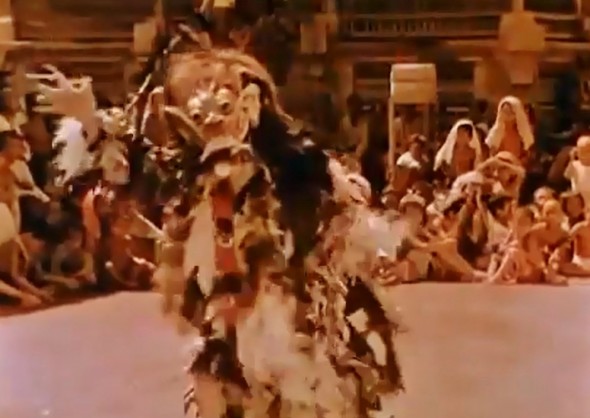

A close reading of the film
The title of the film refers to the Legong dance, one of the most celebrated of all Balinese dances. It dates back to the beginning of the nineteenth century, and its choreography combines elements borrowed from the Sanghyang Dedari tradition, a dance of exorcism performed by two teenage girls in a trance state, and the Gambuh, the prototype of the court theater genre (Picard 1990: 50).
According to popular legend, Prince Karna (a Balinese prince who ruled during the nineteenth century), dreamed that he saw young nymphs in heaven performing a refined and graceful dance. When the prince awoke, he fulfilled his vision by teaching the dance and the music of his meditative dream to his village.
During the early 1920s, the Legong dance became associated with kebyar, a “democratic” and virtuosic performance style linked to the emergence of village gamelans, which separated dance from its dramatic and ritual context. Kebyar transformed the Legong dance into a form of entertainment, just as Western tourists began visiting Bali. As Colin McPhee has explained, kebyar was initially a musical piece played on a gamelan gong gede, which demonstrated the virtuosity of musicians (1966: 328).
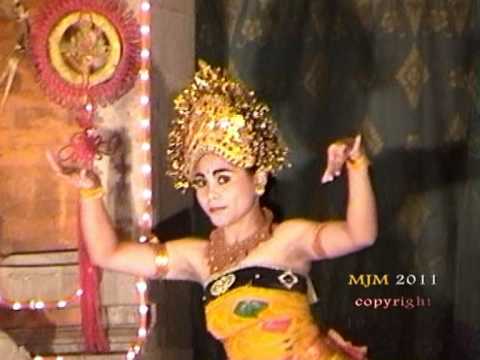
Watch this video on YouTube
Legong: Traditional Balinese Dance
By the late 1920s, villages were melting down their gamelan semar pegulingan ensembles, typically associated with the Balinese royal courts, to make gamelan gong kebyar ensembles. This newer ensemble, featured in the film, was created especially to play the faster, rhythmically explosive genre of music characterized by kebyar. The gamelan gong kebyar, with its quick interlocking patterns and sudden changes in tempo, also influenced the rhythm and style of traditional dances, such as Legong. The interplay between sacred and profane performance is part of the dynamic repertoire of Balinese performance culture, which, from the early 1920s until the present, has evolved in relation to the international tourist economy.
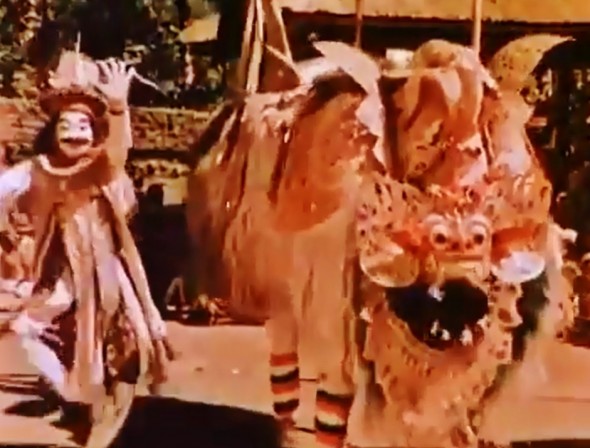

The film is consistently punctuated by scenes of everyday Balinese life such as the marketplace, a cockfight, and extended sequences devoted to the Djanger and Legong dances. Cockfighting is the favorite sport of Poutou’s father Bagus, and the short sequence depicting his fascination with the sport emphasizes the role of the wager and chance in the film.
Perhaps the most impressive of the traditional performances in the film is the Barong temple dance, described as a myth about a prince who is turned into a lion by a the evil witch, Rangda. The emotional intensity of this ritualized dance reaches its pinnacle when Barong, a mythical beast who protects the community, performed by two dancers, confronts and tries to kill Rangda, the personification of death and destruction, performed by a man wearing a frightening mask and a costume with pendulous breasts.
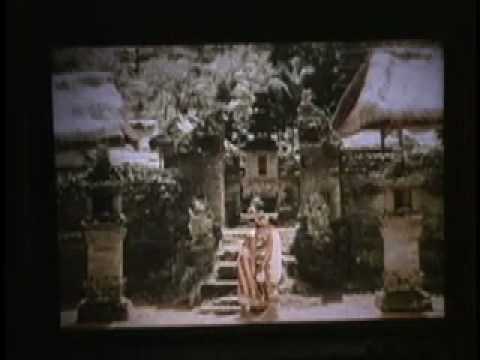
Watch this video on YouTube
Club Foot Orchestra & Gamelan Sekar Jaya play Legong: Dance of the Virgins in San Francisco in 1999.
During the mock battle, the followers of the Barong receive protective powers from him as they attack Rangda. They demonstrate how strong these powers are when, in trance, they turn their ritual swords upon themselves without injury. The film’s intertitles make exaggerated claims here about “sham suicides,” asserting that, “Through courage born of madness—they set out to slay Rangda, the witch. But in accord with the grotesque legend they must fail. And having failed, must sham suicide.”
The Barong/Rangda ritual, a centuries-old tradition that serves to reenact the balancing forces of nature, is considered a stabilizing event by Balinese rather than an uncontrolled display of primitive passions.
To read the entire essay: Click Here.
Books and Articles Referenced
Barnouw, Erik. 1972. “Robert Flaherty (Barnouw File),” in Film Culture, no. 53-54-55, Spring, pp. 161-185.
McPhee, Colin. 1956. Music in Bali. New Haven: Yale University Press.
Picard, Michel. 1990. “’Cultural Tourism’ in Bali: Cultural Performances as Tourist Attraction,” in Indonesia, no. 49, April, pp. 37-74.
Pollmann, Tessel. 1990. “Margaret Mead’s Balinese: The Fitting Symbols of the American Dream,” in Indonesia, no. 49, April, pp.1-35.
Updated 31 March 2023









Pingback: Hindu Epic 'Mahabharata' Balinese Shadow Theatre - WilderUtopia
The Legong tradition continues…. Beautifully documents this graceful culture.